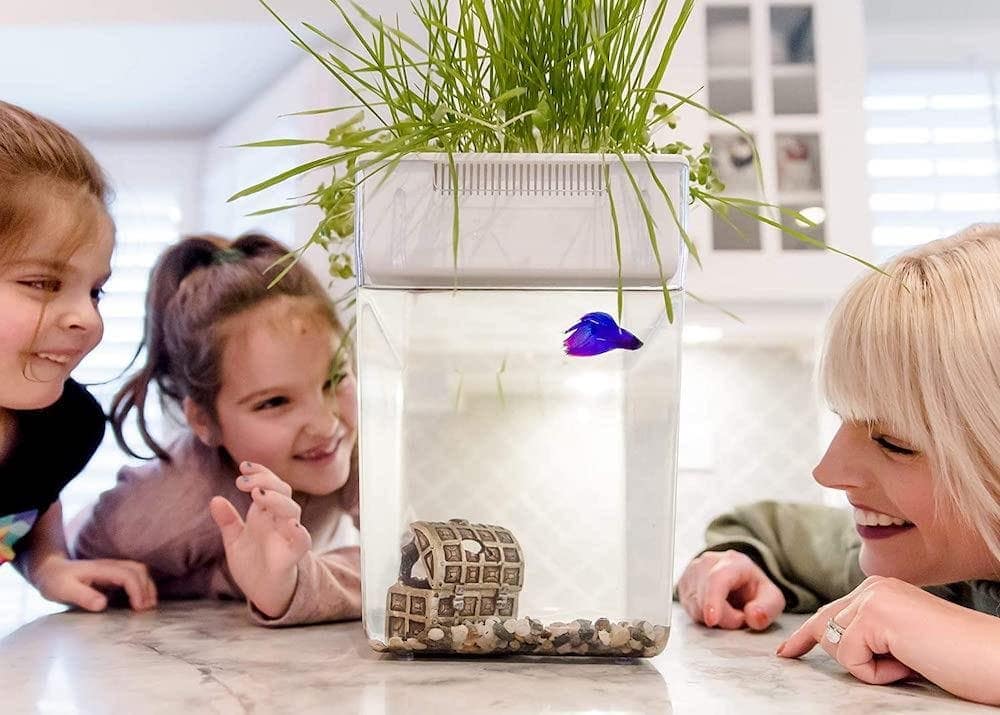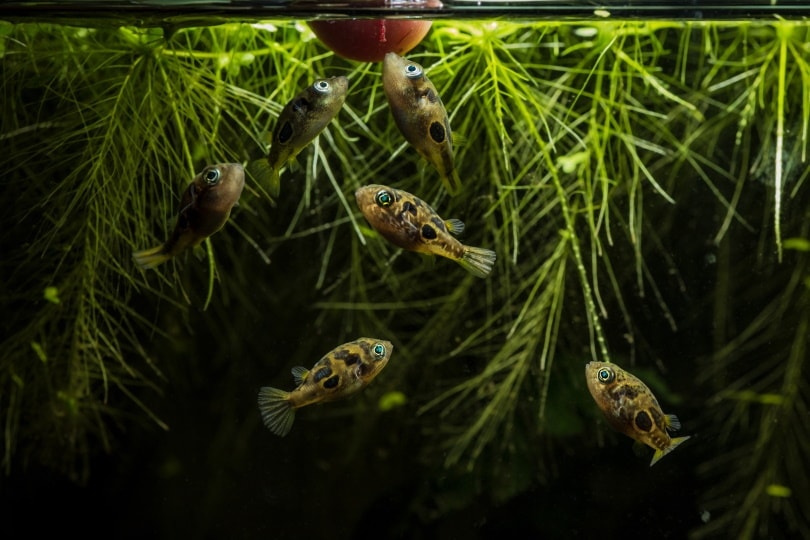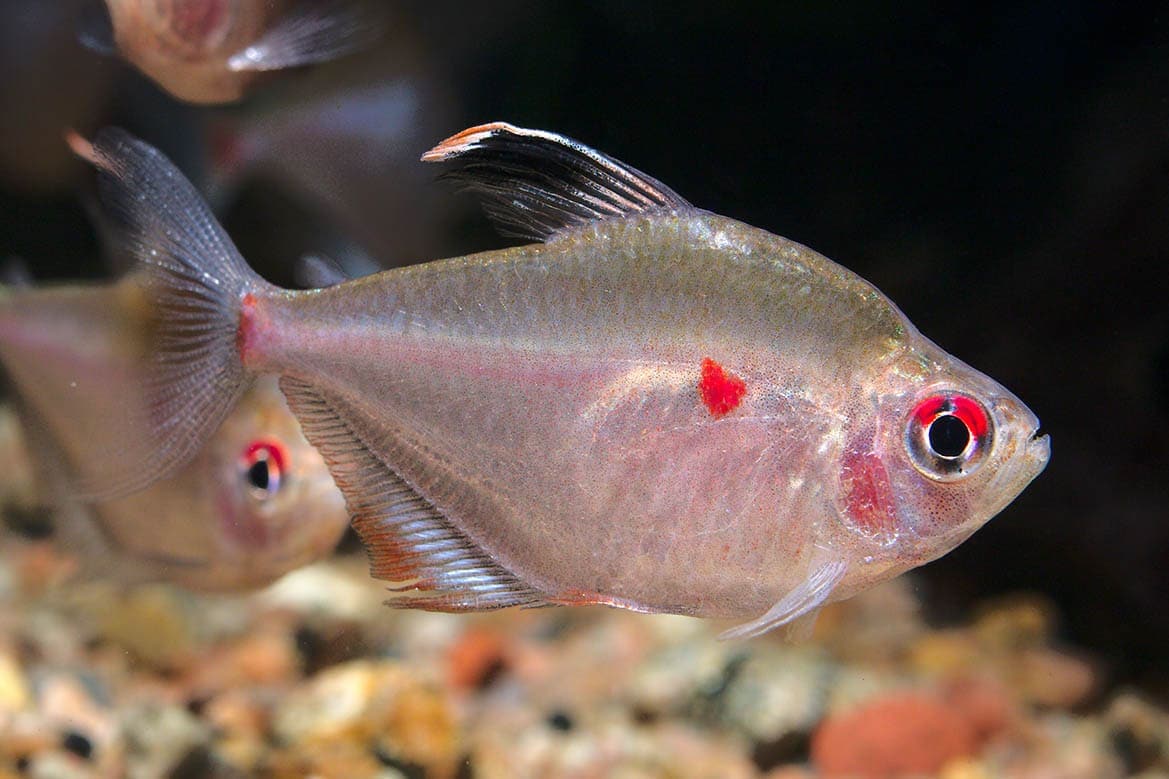Anubias Nana Petite Aquarium Plant: Care & Planting Tips (With Pictures)
Updated on
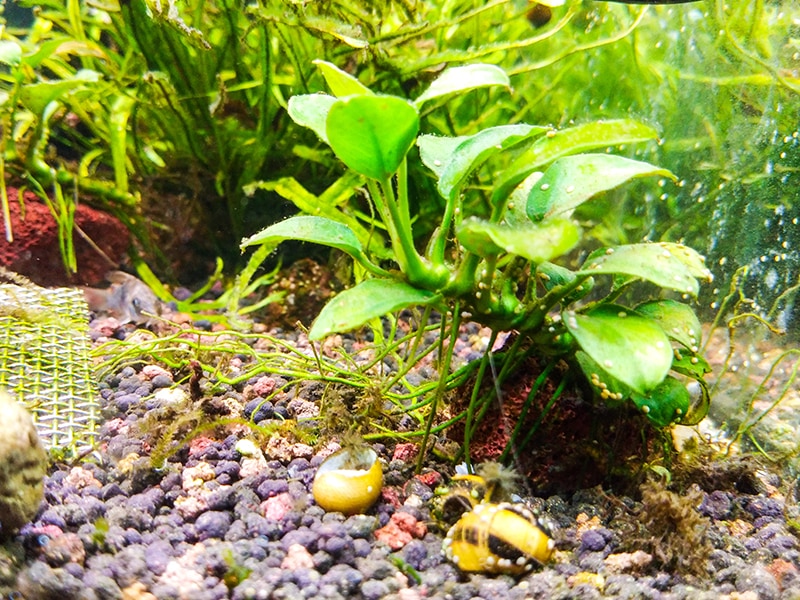
If you’re new to freshwater aquarium plants, you’ll want to start with something simple to care for and hard to kill. The Anubias nana ‘petite’ is one of the plants you should consider investing in first.
This hardy and adaptable plant isn’t hard to care for. Its small size makes it the perfect plant for nano tanks. But because it has such beautiful and rich green leaves, it’s fantastic as a foreground décor in larger aquascapes, too.
If we’ve piqued your fancy, you will want to keep reading. We’ll review everything you need to know about this stunning aquatic plant so you can start growing one in your own aquarium.
Useful Information About Anubias Nana ‘Petite’ Plant
| Family Name: | Araceae |
| Common Name: | Anubias Nana Petite |
| Origin: | Cameroon, Africa |
| Color: | Deep green with white or yellow flower stalks |
| Size: | 3–5 inches |
| Growth Rate: | Slow |
| Care Level: | Easy |
| Lighting: | Low to Medium |
| Water Conditions: | 68–82°F, pH 6–7.5 |
| Minimum Tank Size: | Any size |
| Supplements: | Not necessary |
| Placement: | Almost anywhere |
| Propagation: | Rhizome division |
| Compatibility: | Freshwater shrimp, friendly & aggressive fishes |
Anubias Nana ‘Petite’ Plant Appearance

As its name suggests, Anubias nana ‘petite’ is a small aquatic plant. It is firm in texture with elongated and oval-shaped leaves that grow out of short rhizomes. The leaves are dark green in color with a lighter green underside. Because the leaves are so dark and sturdy-looking, this plant can sometimes be mistaken as artificial.
The Anubias nana ‘petite’ grows just a few inches high with leaves just over a half-inch long. It is a rosette plant, meaning all its leaves will grow to the same size, and its root system will sit near the top of the soil.
This plant has more leaves than its larger counterpart, the Anubias nana, growing around 10 to 15 leaves compared to its counterparts five to six. That said, the petite versions’ smaller leaves do not provide as welcoming an atmosphere.
It is a flower-producing plant, though the flowers may not be visible without using a magnifying glass. Unfortunately, it is rare to see it flower in an aquarium setting, but if you’re lucky enough, you’ll see yours grow whitish or yellowish flowers.
Where to Find It?
Anubias nana ‘petite’ is a commonly available plant that’s easy to find in most aquarium plant stores or even online. However, it is one of the most popular plants in the Anubias species, so you may need to search more thoroughly to find a store that has it in stock.
General Care
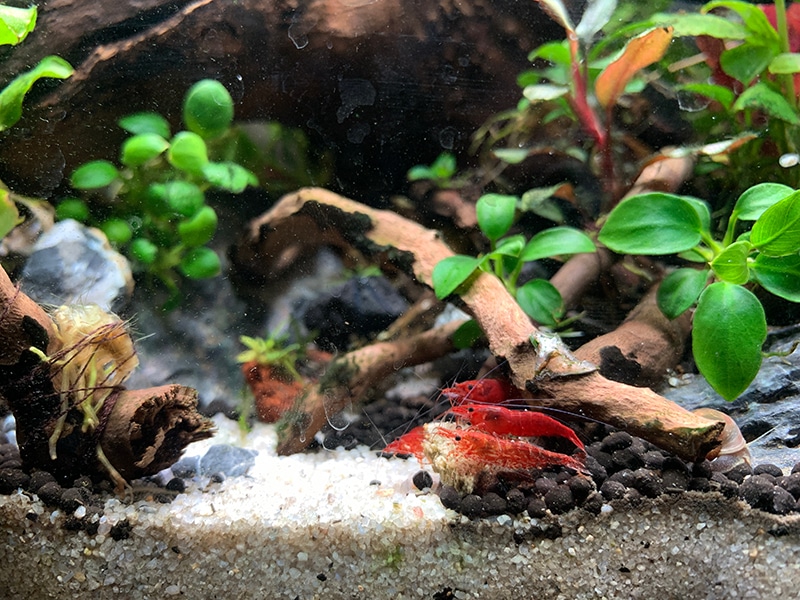
The Anubias nana ‘petite’ is a simple to care for aquatic plant. It doesn’t need much attention and can be floated or attached to your tank décor. Since it tends to clump, it is a great plant for coating driftwood or rocks. Over time, it will secure itself to your décor, and you won’t need to trim it to control its height.
Because it’s so thick, it can even live harmoniously in aquascapes with aggressive fish. In addition, you won’t need to worry about your fish nibbling on the plant’s leaves, as most don’t care for the hardness of the leaves.
It’s very easy to propagate this plant. All you need to do is cut the rhizome, leaving four or five leaves on each section. The rhizome is the stem-like structure from which the roots grow. The plant’s rhizome will keep growing. In optimal growing conditions, the plant will propagate itself by sending out horizontal rhizomes with leaves. Be sure not to bury the rhizome under your substrate, though the actual roots can safely be buried there.
Habitat, Tank Conditions & Setup
Tank Size
Anubias nana ‘petite’ is a desirable aquarium plant because its small size makes it perfect for any tank size. It will live happily in a nano tank or much bigger aquascapes, provided the growing requirements are still met.
Water Temperature & pH
This plant doesn’t need overly specific water temperatures, though they tend to fare best in waters between 68–82°F (20–28°C). That said, this is a pretty hardy plant that can usually adapt to temperatures outside that range.
This plant thrives when grown in waters with a neutral pH between 6.0 and 7.5.
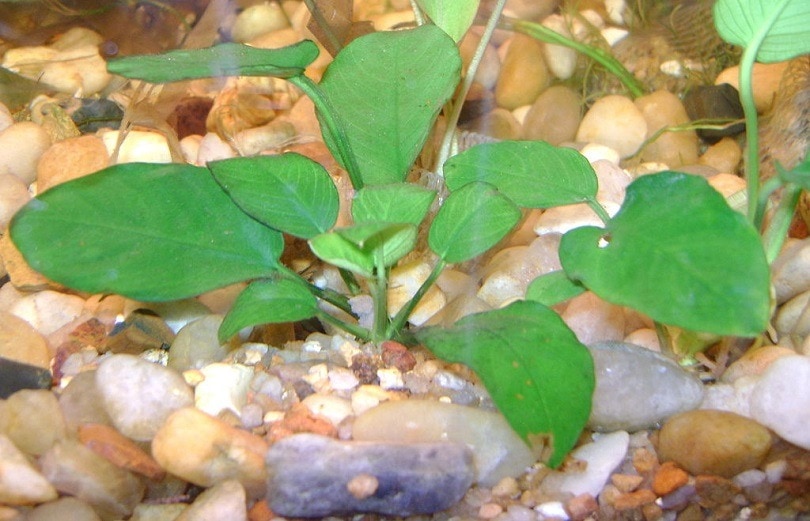
Lighting
An Anubias nana ‘petite’ in its natural habitat prefers low light and higher humidity. In lower light conditions, they’ll have slower growth and less variegation on their leaves.
While many foreground aquarium plants have high lighting requirements, the Anubias nana ‘petite’ is one of the few options that do well under low to medium light. Since it is a slow-growing plant, too much light will promote algae growth, potentially suffocating new leaves and preventing propagation.
Substrate
Softer substrates like sand work best for planting Anubias nana ‘petite.’ However, a high-draining substrate like coir can work well, too. If you use soil, ensure it allows water to pass through while still holding its shape. Pine bark can work.
Make sure the rhizomes of your plant aren’t covered. If you opt for a sand substrate, the water current may eventually push it to cover the rhizome, which will ultimately cause your plant to die. The roots of your plant should be planted in the substrate.
Supplementation
Anubias plants are undemanding in general and can thrive without fertilization. That said, many plants respond well to fertilizer and CO2 supplementation, so the choice is up to you whether you’d like to use it or not.
If you choose to use fertilizer on your nana ‘petite’, use a liquid fertilizer with many micro-nutrients. That said, if you keep fish in the tank with your plants, the nutrients from their food and waste will be more than enough for these hardy little plants.
Filtration
Filtration is an important part of caring for any aquatic plant. Though Anubias nana ‘petite’ doesn’t have any specific filtration needs, not having a high-quality filter will increase the chances of developing problems with algae.
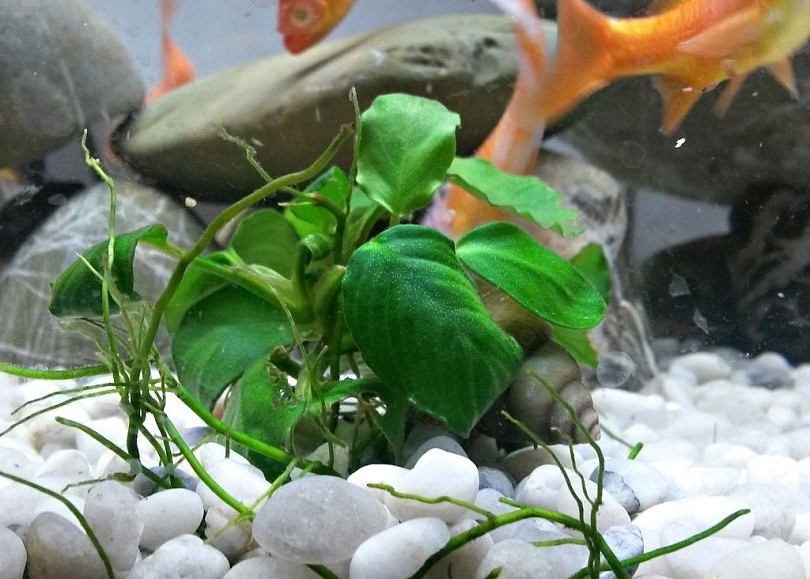
Planting Tips
Planting an Anubias nana ‘petite’ is exceptionally easy as it can be planted in multiple places. All you need to do is attach it to a rock or piece of driftwood in your tank with a piece of fishing line. However, do not remove the fishing line until your plant has had a chance to gain hold. This can take some time, so stay patient. You should expect to wait at least a month and a half for it to attach to your décor.
You can also plant your petite into a prepared substrate. However, take care not to plant it too deeply in your substrate, as the rhizome can rot, causing your plant to die.
Anubias nana ‘petite’ can also live happily in the midground or foreground of your tanks.
The 4 Benefits of Having Anubias Nana ‘Petite’ Plants in Your Aquarium
1. Perfect for Small Setups
The Anubias nana ‘petite’ plant’s leaves only grow to be around half an inch long. Its small size makes it a perfect plant for nano tanks and for use in the foreground or as an accent plant in larger aquascapes.
2. Low Maintenance
Anubias nana ‘petite’ plants are very low maintenance, making them a perfect pick for newbies entering the world of aquascapes. While many other foreground aquarium plants have high lighting requirements, this plant does just fine with low to medium light. Since it is a slow-growing plant, high light will promote unwanted algae growth, preventing new leaf growth and putting a damper on propagation.
3. Can Grow Almost Anywhere
The Anubias nana ‘petite’ can be planted almost anywhere in an aquarium or terrarium as long as the growing conditions mentioned above are met. It can be floated in your tank, planted above your substrate, or attached to your decorations. Most people find it is most decorative when attached to stones or roots. As with other Anubias plants, you should connect it to your décor with a fishing line until it’s had a chance to gain hold.
Note: If planting in the bottom of your tank, do not cover the rhizome. Doing so may cause the plant to rot and die.
4. Hardiness
Don’t let this plant’s small size confuse you, though; it is a hardy and strong plant. You can even plant it in tanks with more aggressive fish because its thick and sturdy leaves can withstand almost anything.
Concerns About Anubias Nana Petite Plant
Algae growth is the most common issue you’ll run into with Anubias nana ‘petite’. The most common cause of this issue is excessively strong lighting and too nutrient-rich water. You’ll most often see algae problems when you’ve recently added a plant to your aquarium, as it hasn’t yet had a chance to establish a healthy root system and hasn’t had the opportunity to adapt to your water parameters.
Another issue you could see with your Anubias nana ‘petite’ is rotting due to its rhizome being planted below the surface of your substrate. You can easily avoid this problem by planting it so the rhizome is uncovered.
Final Thoughts
The Anubias nana ‘petite’ is a beautiful aquatic plant that will make a statement in your home aquarium regardless of size. It’s a perfect pick if you’re new to the world of aquatic plants, as it’s so simple to care for and hard to kill. Provide the right environment, and your aquascape will have a beautiful decorative accent that’s hard to beat. And don’t worry if your tank conditions aren’t 100% right off the bat. This hardy plant will thrive in almost any condition!
Featured Image Credit: nuzaa, Shutterstock


